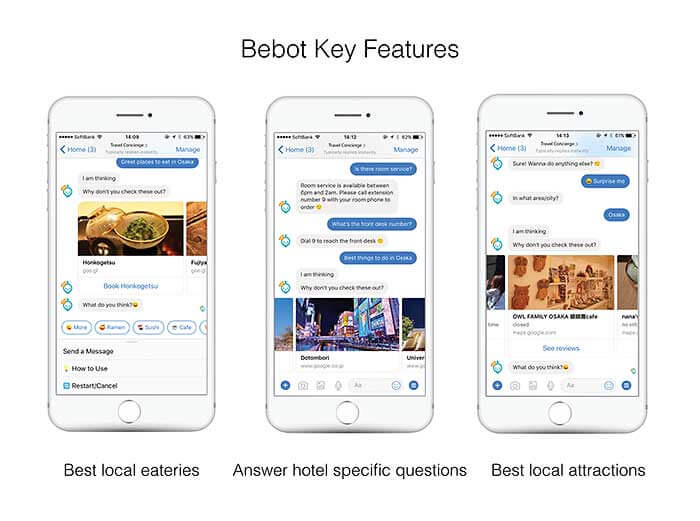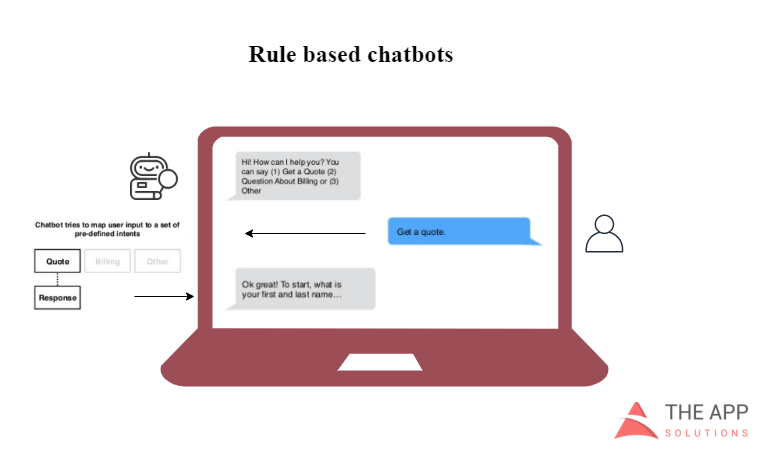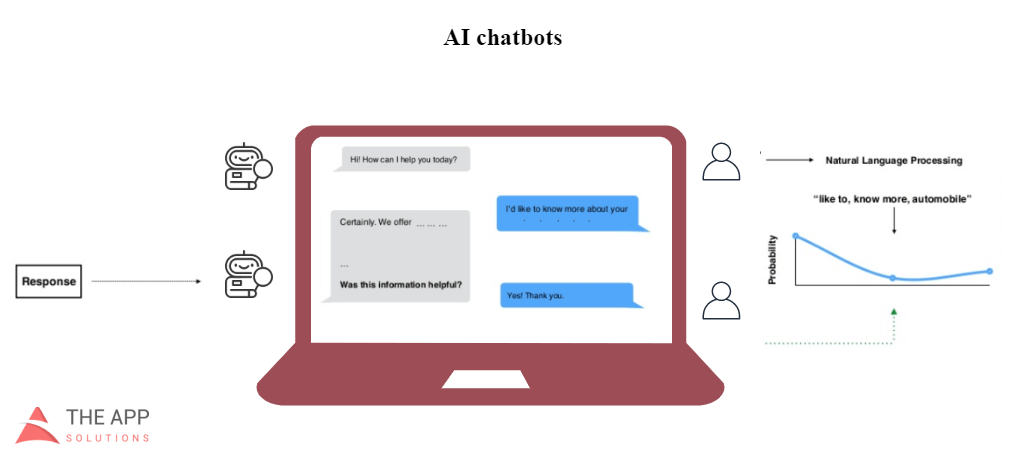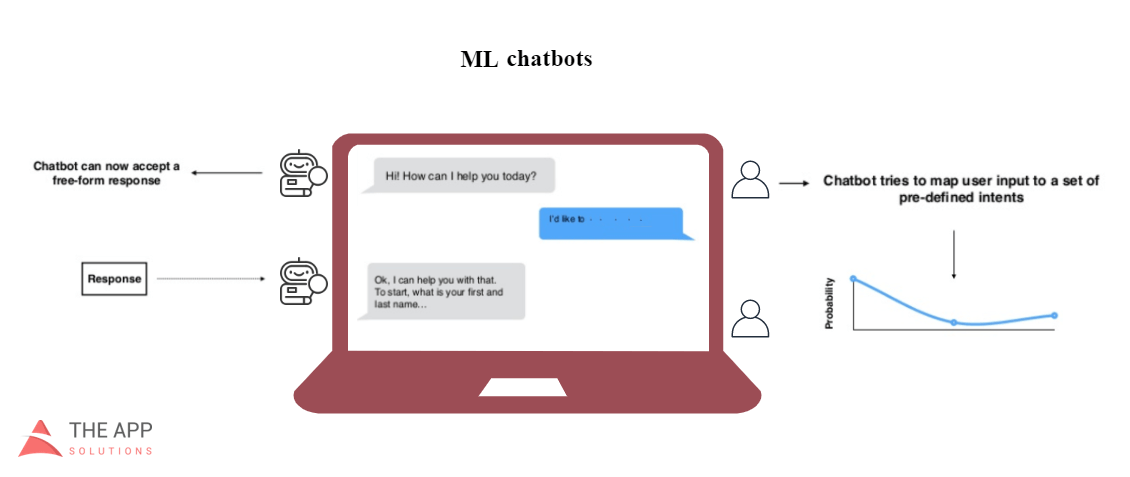Chatbot for travel industry: benefits, use cases, and a development guide
- Why you need a travel chatbot for business: top 5 benefits
- The most successful use cases of travel agency chatbots
- How to develop a chatbot for a travel agency in 6 steps
- Step 1. Decide the chatbot’s functionality
- Step 2. Choose the chatbot type
- Step 3. Evaluate chatbot channels
- Step 4. Choose the best platform
- Step 5. Develop a chatbot MVP
- Step 6. Enrich chatbots for travel sector with additional features
- How much does it cost to develop a chatbot: rule-based vs ai vs custom
- Wrapping up
What does a perfect vacation overseas consist of? Before taking a sunbath on the beach, you need to spend time to find accommodation within your budget, book a flight, and spend at least two hours to check-in — that’s how this was before chatbots in the travel industry appeared. Now, using a chatbot and your smartphone, you can book and pay for hotels, flights, and even check-in online without a hassle.
If you want to develop a chatbot for your travel agency, this article is right for you. Below, we share the most successful usage of travel chatbots and a step-by-step guide on how to develop one.
But first, let’s find out what the advantages of using a chatbot for your travel business are.
Why you need a travel chatbot for business: top 5 benefits
Online travel companies are simplifying the way we organize our vacation. When planning a trip, around 84% of travelers use online travel booking agencies, such as Kayak, Expedia, or TripAdvisor. Still, the market of travel booking is flooded with irrelevant options, and to find the best one, travelers visit 38 sites on average, and for 62% of travelers, it is hard to find the right deal. At the same time, Huxley’s survey said 87% of travelers want to interact with a travel chatbot to find the best accommodation while saving time for the indecisive search. Moreover, 79% of them expect a travel chatbot to perform as an online travel concierge.
And now, let’s look at chatbots from a business perspective.
Consider integrating a chatbot to your travel business, since it will bring the following benefits:
- Increase engagement. As we have said, travelers are looking through various travel websites to find the best trip. At the same time, if your online travel chatbot can provide users with relevant offers, your agency will become more valuable for your clients and increase the engagement rate.
- Reduce workload and operation costs. When a traveler is interested in a particular tour or hotel, one is more likely to ask a question to receive more information. The bad news is that your customer support team spends at least two hours a day answering repetitive questions. FAQ chatbot can provide travelers with answers to basic questions, thus reducing both the workload on your employees and customer support costs up to 30%.
- Increase sales. Travelers want to book a hotel, rent a car or pay for their ticket as quickly as possible and find long forms an unpleasant and irritating experience. Thanks to the integrated payment gateway, a Messenger travel chatbot could seamlessly get your customers through the sales funnel and close a deal with fewer interactions. To achieve this, travelers need to enter their credit card information into Facebook Messenger, and the platform will save it for next friction-free payments.
- Built community. Apart from business logic, like built-in payment and booking, a chatbot could be a handy tool for building a community around your travel agency by sharing their travel experience and inspiration. To achieve this, you can cooperate with influencers and travel bloggers, post their articles or videos in your blog, and suggest this content to travelers via a chatbot.
- Attract new customers. Customer acquisition cost is an essential metric, not only in travel but also in other industries. Proactive travel chatbots decrease CAC and attract new customers most effectively by starting a conversation. You can empower a bot to send a welcome message to anyone who makes a booking on your website or place a comment on your Facebook page. Besides, your chatbot can send relevant information based on keywords used by your customers.
In a nutshell, chatbots can improve the booking experience of your customers by providing them with more relevant recommendations, while enhancing your business metrics and saving operation costs.
The most successful use cases of travel agency chatbots
And now, let’s find out about famous travel chatbot use cases and what results they receive from such an integration.
- Reservation agent
By using this type of chatbot, travelers can book airline tickets, make hotel reservations, car rentals, cruises, and even vacation packages via their website or Facebook page. To get relevant offers, travelers need to provide the bot with their requirements such as destination, date, type of accommodation, price range, and so on.
The chatbot by travel agency Expedia.com works on this scenario. After the user receives relevant hotel search results, one is redirected to Expedia’s website to make a direct booking. Then, the chatbot sends a user a link with itinerary in Messenger. Apart from Facebook Messenger, travelers can use this bot on Amazon Alexa virtual assistant and ask for booking updates via voice commands.
- Personalized digital travel assistant
With natural language processing (NLP), travel chatbots recognize particular user queries such as “exotic Japanese weekends” and provide one, not only with hotel recommendations and transportation but also with local places to visit. Travelers receive immediate and relevant recommendations without conducting long surveys. Moreover, such chatbots help travelers to find the nearest rental car service and give local weather forecasts while keeping in mind the traveler’s budget and even dietary requests. In this way, personalized travel assistants help travelers at each stage of their travel and keep all their documents and tickets in one place.
One example is the Mezi AI chatbot, recently acquired by American Express. The company motto is “everyone traveling for work deserves a first-class experience.” This chatbot allows travelers to book hotels, flights, and even a table at restaurants.
- Customer care manager
This use case of travel chatbot provides travelers with check-in notification, flight status updates, boarding pass, and even booking confirmation via the chosen channel, and simplifies the customer service.
This exact type of chatbot is used by KLM Royal Dutch Airlines, built on the DigitalGenius platform. The company’s AI chatbot, trained with over 60,000 questions and answers, can provide travelers with non-pre scripted answers about information and updates on their flight via Facebook Messenger. After the bot launch, the KLM Facebook page received 40% more messages. Currently, KLM chatbot speaks 13 languages and responds to 15,000 queries in Messenger weekly. Since its release date, KLM chatbot answered 1.7 million messages sent by over 500,000 people.
Apart from social media networks, KLM also developed a chatbot for Google Assistant. The bot answers frequently asked questions, provides information about airline requirements via voice, and can even give tips on how to pack bags for a flight based on destination.
- Two-sided chat agent
If you own a two-sided travel marketplace, this bot travel use case will be useful for your business. This type of chatbot connects travelers and hotels to check hotel availability, look up necessary information such as check-in times, or parking reservations. The two-sided nature of this chatbot allows hotels to send notifications in response to user queries.
This type of travel chat app was developed by Booking.com, a travel marketplace. Right now, the chatbot can respond to 30% of customers’ hotel-related questions in under 5 minutes, according to Booking.com.
- Local insider
Many travelers are going to another country searching for an authentic experience. They want to eat, entertain, and live as the locals do. If you’re going to provide travelers with local recommendations on restaurants with local cuisine, festivals, and other activities, a local insider chatbot will be the best choice. In this way, your customers will receive relevant information without spending hours searching for the most recommended places on social networks.
An excellent example of such a tourism chatbot is Bebot, launched on the threshold of the Tokyo 2020 Olympic Games. The main goal of this bot is to illuminate cultural and language barriers for an increasing number of foreign tourists. This bot help users to receive personalized recommendations on sights, local food and helps navigate around the country.

[Source: Medium]
How to develop a chatbot for a travel agency in 6 steps
Below, we have gathered the main steps you need to complete to create the best chatbot for your travel agency.
Step 1. Decide the chatbot’s functionality
At this step, you need to define the purpose of your chatbot, set up goals and objectives. To determine the proper chatbot objectives, you need to answer the following questions:
- What is your business size?
- Do you need a chatbot to handle customer queries or to entertain people?
- What business process you want to automate with your chatbot?
- How many people will use your chatbot?
- Do you need an integration of your chatbot with databases, CRM, or CMS?
After answering these questions will help you have a clear idea about your chatbot project, and you can enter the next step.
Step 2. Choose the chatbot type
Once you know the objectives of your project, it will be easier for you to choose the right chatbot type from among the following:
Rule-Based or Scripted Chatbots are the simplest type because they use a decision tree to communicate with users. When communicating with users, scripted bots recognize keywords and channel them down the correct path to achieve their goals, like information about current best deals, and so on. Such chatbots have a very limited skill set. Still, you can use them for simple tasks such as:
- Customer support agents that provide customers with automated responses
- Engagement bots that inform customers about special offers

AI-Powered Chatbots are more complex chatbots, often empowered with Natural Language Processing (NLP) and Machine Learning (ML) algorithms. Unlike rule-based chatbots, AI-powered bots can answer a user with non-pre defined responses, and ML helps them to learn from each integration with the user and remember one’s preferences.
Choose this type of chatbot if you want to develop:
- Booking agents that help users to buy or book something
- Recommendation agents that gather requirements from the customer and then show relevant results
- Personal travel concierge that will help users find, not only hotels but also book flights and provide the user with local insights
- Comparison chatbot that will compare hotel rooms and flight ticket prices
- Automated check-in chatbot that allows the user to check-in to the flight or hotel
Step 3. Evaluate chatbot channels
Now, you should consider where you can use your chatbot. The most popular channels for chatbots are:
- Embedded chat on your travel website,
- Your mobile travel application;
- Mobile carrier channels (SMS, USSD)
- Messaging app (Facebook Messenger, WeChat, Kik, Line, Viber)
- If you want to use a chatbot in both your website, Facebook Messenger and Telegram, you can create an omnichannel chatbot,
Then you need to make sure whether or not the chosen channels offer an open API, so your travel chatbot developers can integrate it easily. In this case, the most effective strategy is to select the most popular channel among your users and integrate a chatbot to other channels with time.
Step 4. Choose the best platform
Depending on your chatbot type and communication channel, you will select the platform to build your future chatbot.
To build a scripted-based chatbot with if/then logic, you can use one of the following platforms:
- Hubspot conversations
- Chatfuel
- Facebook Messenger
Since these platforms have an intuitive drag-and-drop menu, you can create a chatbot without hiring chatbot developers.
However, if you want to create a more sophisticated AI and ML bot that solves complex business tasks, consider that you’ll need to hire chatbot developers for initial bot settings and training. As for a technological solution, consider the following platforms for building AI chatbots:
- AWS
- Wit.ai
- IBM Watson Assistant
- Microsoft Bot
If you need to create a custom chatbot, you will need to hire chatbot developers to work on the following custom chatbot components:
- The script of the custom chatbot will include the whole dialogue from a greetings message, which gathers the user’s requirements, to the “goodbye” message. Also, consider those scenarios where the bot will not understand the user’s input and cases when the bot will need to switch the communication with the traveler to a human agent.
- NLP, also known as Natural Language Processing, helps a chatbot to extract the user intent, i.e., understand what your users want by defining particular entities in the message.
- The backend of a custom chatbot should process messages with Natural Language Processing. The custom chatbot backend should also comprise business logic and include third-party integrations, like payment gateways.
Step 5. Develop a chatbot MVP
Now you need to hire chatbot developers that will help you to prioritize the chatbot’s business tasks and implement the most important features in the travel chatbot MVP.
An MVP means a minimum viable product. This approach is used in software development when a client wants to test a hypothesis without spending a considerable amount.
To give you an idea of the travel chatbot’s main features, as well as the project scope, we made a travel chatbot MVP estimated in hours.
| FeatureScreen | Functions required | BackEnd |
| Architecture | 12 hours | |
| Customization for agents |
| 60 hours |
| Connection to Data Server API | 16 hours | |
| Switching between a chatbot and human agent |
| 32 hours |
| Gathering of data from a user (Search for hotel, tour, full package flow) |
| 32 hours |
| Data transferring to API, receive results | 16 hours | |
| Tour Proposals (Search Results) |
| 8 hours |
| Show more variants | 16 hours | |
| Admin Login | 8 hours | |
| Chatbot Management |
| 40 hours |
| Total | From 240 hours |
Step 6. Enrich chatbots for the travel sector with additional features
At this step, your development team launches the chatbot MVP. But this is not the end of your chatbot development process. Why? Because at this step you need to thoroughly analyze how your chatbot interacts with your customers. To achieve this, ask your customers to test your chatbot and give feedback. You may also ask them what features you need to implement to your chatbot during the second development stage. Consider that chatbot creation is an iterative process that includes gathering the data, reviewing and applying changes to the chatbot.
Now that you are aware of the main steps of chatbot development, it is time to find out about chatbot development costs.
How much does it cost to develop a chatbot: rule-based vs ai vs custom
As we have said, you can create a simple rule-based chatbot with DIY platforms, so you save money on chatbot developers. Most chatbot platforms are free to use, but also have paid premium plans:
| Platform | Pricing plans |
| Hubspot conversations | Free of charge |
| Chatfuel |
|
| Facebook chatbot | Free of charge |
To develop AI-based chatbots you will need to hire a chatbot development team for bot training, third-party integrations and other settings. Consider that the hourly rate of chatbot developers varies from country to country and level of experience.
Front end developer hourly rates across countries:
- The U.S. from $90/hour
- Western Europe from $60/ hour
- Eastern Europe from $40/hour
Back-end developer hourly rates
- The U.S. from $120/hour
- Western Europe from $80/ hour
- Eastern Europe from $50/hour
In addition, take into account the following costs charged by AI chatbot development platforms:
| Platform | Pricing policy |
| AWS Lex | Free plan – up to 10,000 text requests and 5,000 speech requests per month After a year’s trial period, you are charged based on the number of text or voice requests processed by your bot:
|
| Wit.ai | On request |
| IBM Watson Assistant |
|
| Microsoft Azure Bot Service | On request |
The cost to create AI chatbot starts from $6000, and the development stage takes 3 months.
As for custom chatbot development, this is the most costly option. To create a custom chatbot you need to hire a development team, including front and back end developers, designers, QA engineers, and project managers, who will work on your project. That is why custom chatbots are so expensive – the price of custom chatbots starts from $40,000, and the development stage might take from six to eight months.
Want to Learn More About The APP Solutions Approaches In Project Development?
Download Free EbookWrapping up
If you want to stay ahead of competitors, provide customers with a high-quality customer experience, and keep them engaged, your travel business needs a travel chatbot.
With many usage cases, you can develop a chatbot to meet the needs of a travel business of any size.
Besides, with a wide range of DIY building platforms, you can even create a simple chatbot by yourself.
But, if you want to automate business operations with an AI travel chatbot, you will need to hire a chatbot development team for initial bot settings.
Related articles:
HOW CAN CHATBOTS HELP E-COMMERCE BUSINESSES?
WHAT IS THE BEST WAY TO CREATE A CHATBOT: PLATFORM VS. CUSTOM


